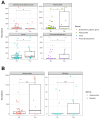Interplay Between Helminth Infections, Malnutrition, and Gut Microbiota in Children and Mothers from Pemba, Tanzania: Potential of Microbiota-Directed Interventions
- PMID: 39683417
- PMCID: PMC11643142
- DOI: 10.3390/nu16234023
Interplay Between Helminth Infections, Malnutrition, and Gut Microbiota in Children and Mothers from Pemba, Tanzania: Potential of Microbiota-Directed Interventions
Abstract
Background/objectives: Despite efforts within the framework of the Sustainable Development Goal to end malnutrition by 2030, malnutrition and soil-transmitted helminth infections persist in sub-Saharan Africa. A significant barrier to success is the inadequate understanding of effective intervention methods. Most research on the gut microbiota's role in health has been conducted in developed countries, leaving a critical gap in knowledge regarding low-income populations. This study addresses this gap by expanding research on the gut microbiota of underprivileged populations to help tackle these public health challenges.
Methods: We employed 16S rDNA sequencing to assess the bacterial gut microbiota composition of 60 children (mean age: 26.63 ± 6.36 months) and their 58 mothers (mean age: 30.03 ± 6.31 years) in Pemba, with a focus on helminth infection and nutritional status.
Results: Our differential abundance analysis identified bacterial taxa that were significantly negatively associated with both helminth infections and malnutrition, highlighting the potential for microbiota-directed interventions to address these health issues simultaneously. Notably, we identified Akkermansia, Blautia, Dorea, and Odoribacter as promising probiotic candidates for such interventions. In stunted children, positive co-occurrences were observed between Lactobacillus, Prevotella, and Bacteroides, while Escherichia/Shigella displayed negative co-abundance relationships with short-chain fatty acid (SCFA) producers in the gut microbiota. These findings suggest that administering Lactobacillus and SCFA-producing probiotics to children may foster the growth of beneficial bacteria like Prevotella and Bacteroides while reducing the relative abundance of Escherichia/Shigella, potentially enhancing overall health.
Conclusions: This study underscores the importance of microbiota-directed interventions in children and women of reproductive age as promising strategies, alongside established approaches, for combating helminth infections and malnutrition in vulnerable populations.
Keywords: Ascaris; Trichuris trichiura; children; gut microbiota; helminth; malnutrition; stunting; underweight; wasting; women of reproductive age.
Conflict of interest statement
The authors declare no conflicts of interest.
Figures






Similar articles
-
Dissection of the gut microbiota in mothers and children with chronic Trichuris trichiura infection in Pemba Island, Tanzania.Parasit Vectors. 2021 Jan 19;14(1):62. doi: 10.1186/s13071-021-04580-1. Parasit Vectors. 2021. PMID: 33468220 Free PMC article.
-
Association between Food or Nutrients and Gut Microbiota in Healthy and Helminth-Infected Women of Reproductive Age from Zanzibar, Tanzania.Nutrients. 2024 Apr 24;16(9):1266. doi: 10.3390/nu16091266. Nutrients. 2024. PMID: 38732513 Free PMC article.
-
Relationship between infant gastrointestinal microorganisms and maternal microbiome within 6 months of delivery.Microbiol Spectr. 2024 Oct 3;12(10):e0360823. doi: 10.1128/spectrum.03608-23. Epub 2024 Aug 22. Microbiol Spectr. 2024. PMID: 39172626 Free PMC article.
-
Helminth-Induced Human Gastrointestinal Dysbiosis: a Systematic Review and Meta-Analysis Reveals Insights into Altered Taxon Diversity and Microbial Gradient Collapse.mBio. 2021 Dec 21;12(6):e0289021. doi: 10.1128/mBio.02890-21. Epub 2021 Dec 21. mBio. 2021. PMID: 34933444 Free PMC article.
-
Malnutrition and Gut Microbiota in Children.Nutrients. 2021 Aug 8;13(8):2727. doi: 10.3390/nu13082727. Nutrients. 2021. PMID: 34444887 Free PMC article. Review.
Cited by
-
Compound of Lactobacillus reuteri and Candida rugosa supplementation alleviates intestinal barrier lesion via improving the gut microbiota in broilers infected with Salmonella Typhimurium.Poult Sci. 2025 Jun 11;104(9):105417. doi: 10.1016/j.psj.2025.105417. Online ahead of print. Poult Sci. 2025. PMID: 40541101 Free PMC article.
References
-
- WHO . Reducing Stunting in Children: Equity Considerations for Achieving the Global Targets 2025. WHO; Geneva, Switzerland: 2018. [(accessed on 31 March 2020)]. pp. 1–25. Available online: https://www.who.int/nutrition/publications/severemalnutrition/reducing-s...
-
- Ministry of Health, Community Development, Gender, Elderly and Children (MoHCDGEC) [Tanzania Mainland]’ Ministry of Health (MoH) [Zanzibar] Tanzania Food and Nutrition Centre (TFNC) National Bureau of Statistics (NBS) Office of the Chief Government Statistician (OCGS) [Zanzibar] UNICEF . Tanzania National Nutrition Survey Using SMART Methodology (TNNS) 2018. MoHCDGEC, MoH, TFNC, NBS, OCGS, and UNICEF; Dar es Salaam, Tanzania: 2018.
MeSH terms
Substances
Grants and funding
LinkOut - more resources
Full Text Sources
Medical
Miscellaneous

